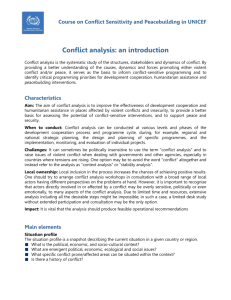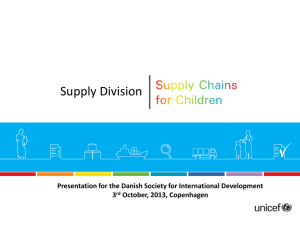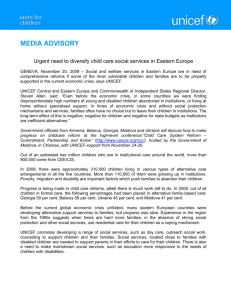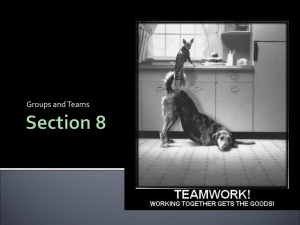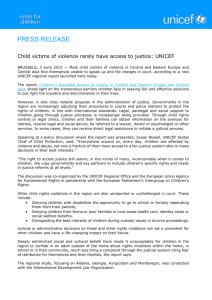Causality Analysis Slides
advertisement
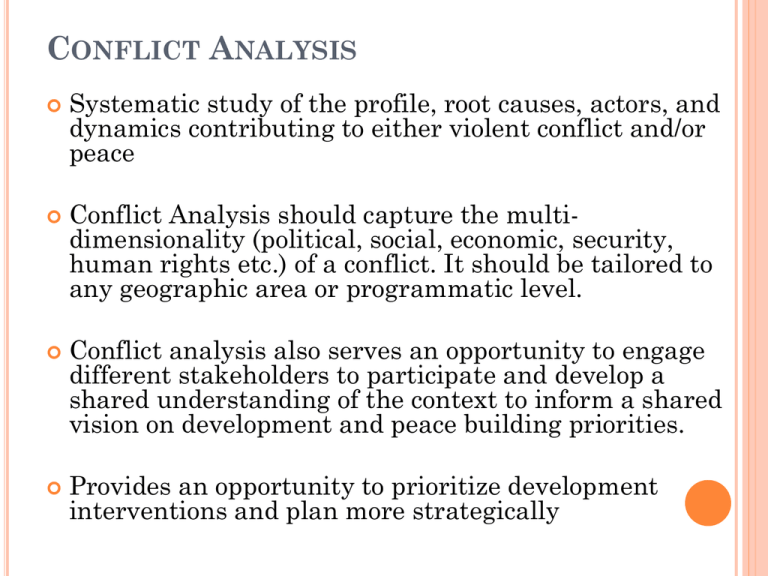
CONFLICT ANALYSIS Systematic study of the profile, root causes, actors, and dynamics contributing to either violent conflict and/or peace Conflict Analysis should capture the multidimensionality (political, social, economic, security, human rights etc.) of a conflict. It should be tailored to any geographic area or programmatic level. Conflict analysis also serves an opportunity to engage different stakeholders to participate and develop a shared understanding of the context to inform a shared vision on development and peace building priorities. Provides an opportunity to prioritize development interventions and plan more strategically WHAT CONFLICT ANALYSIS IS NOT Common sense and perception of dynamics An academic piece Not a desk report Not a chronology Not an compilation of reports Not a one-off exercise Context Analysis A separate exercise de-linked from planning and programming KEY ELEMENTS OF CONFLICT ANALYSIS Profile/Situation Causal Analysis Analysis Stakeholder Analysis Analysis of Conflict Dynamics Prioritization KEY FEATURES OF CONFLICT ANALYSIS There are many frameworks and methodologies on conflict analysis available. UNICEF uses the “UN conflict analysis methodology” adaptable to the diverse planning scenarios Conflict analysis is part of several inter-agency planning frameworks- UNICEF needs to be an active player Process is as important if not more than the outcome. KEY FEATURES OF CONFLICT ANALYSIS Quality conflict analysis requires appropriate investment by the Country Office (staff, resources, time, process) Conflict analysis is only useful if translated into the programming cycle Important for UNICEF is the identification of both root causes and conflict triggers because of dual mandate. UNICEF AND CONFLICT ANALYSIS Building on inter-agency and broader conflict analysis, zoom in on conflict dynamics particularly relevant for children and women, including: - Social dimensions of conflict - Children’s rights - Gender - Equitable access to services - Protection and security - Adolescents and youth - Restoring the citizen-state social compact Causal Analysis framework VIOLENT CONFLICT Conflict triggers Underlying causes Root causes Source: FAO PROBLEM TREE EXAMPLE (ADAPTED FROM UNDP KENYA/ACORD/NSC*) Effects Children out of school Food insecurity Displacement Loss of livelihoods Closure market Cattle killing Continued insecurity Destruction of houses public infrastructure Emotional and physical damage Violence, Killing of humans Violent conflict between x and y Problem Lack of dispute resolution mechanisms Group x marginalized Causes Rape of girls fetching water Past forced relocation of x to area y Ethnic mistrust Limited access to education, health, water Youth unemployment Inequitable access to natural resources Prevalence of small arms Spill-over from conflict in X * Publication by UNDP Kenya, Acord, and the Kenyan National Steering Committee for Peace building: Community Peace Recovery and Reconciliation Exercise – Problem Tree Instructions 1. Based on the analysis you did on your country situation, identify one key problem that has a direct link to the main conflict dynamics in the country. 2. Identify causes of the key problem at 2 levels: - conflict triggers - underlying/root causes 3. Identify existing and potential effects of the problem.
